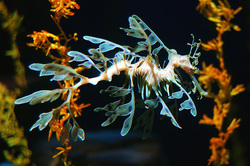 Leafy Sea Dragon Leafy Sea Dragon I have not posted anything in the Ocean Wildlife section for a while, so I decided to correct this by telling you all about a very strange sea creature: The Leafy Sea Dragon. The Leafy Sea Dragon, native to the Southern and Western coasts of Australia, gets its name from the leaf-like protrusions which cover its body. These protrusions enable the Leafy Sea Dragon to camouflage itself as a piece of floating seaweed. It has two translucent sets of fins, a pectoral fin on the ridge of its neck, which it uses to steer itself through the water, and a dorsal fin towards the tail, which it uses for propulsion. Its nose and general upper body shape is reminiscent of the sea-horse, to which it is related. Unlike the sea-horse, however, the Leafy Sea Dragon is unable to move its tail, and cannot hang on to seafloor foliage during rough weather. The Leafy Sea Dragon is part of the Syngnathidae family, along with seahorses, pipefish, and the weedy sea dragons. The family name is derived from Greek: syn meaning fused or together and gnathus meaning jaws. The fused jaw is a feature found in the whole family. Another trait of this particular family is that the males of the species carry and incubate the fertilised eggs. Unlike male seahorses, who store the eggs in a specialised ventral pouch, the male Leafy Sea Dragon stores the eggs on a brood patch which supplies them with oxygen. They are placed on to the male's body via a tube extending from the female’s body, which deposits the eggs on the underside of the male's tail. While the female can deposit up to 250 bright pink eggs on for incubation on the male’s body, only about 5% of those will reach maturity, which is about 2 years. The Leafy Sea Dragon is slightly bigger than most seahorses, averaging about 8 to 10 inches (20 to 24cm) long, but can reach up to 18 inches. At the head end of its weird and fabulous body is a pipe-like snout, with which it catches its prey. This snout is also a common feature of the Syngnathidae family. Sea dragons feed mainly on larval fish, amphipods, and small shrimp-like crustaceans called mysids, otherwise known as "sea lice". Most of its prey lives on the red algae which makes its home in the shade of the kelp forests which is one of the main habitats of the Leafy Sea Dragon. Leafy Sea Dragons are also found by rocks, jetties, and raised sand dunes in water no more than 50m (164 feet) deep. Most of the dangers faced by the Leafy Sea Dragon are man-made. The main danger is that of a change in the conditions of its natural habitat. As the Leafy Sea Dragons live in relatively shallow waters, the effects of man’s lifestyle are all to easily felt. Sewage outlets can poison both the Leafy Sea Dragon and its food sources. Boating, and the anchoring of boats, can also damage the delicate eco-systems that sustain the creatures, as can dredging, which destroyes the habitat of its prey. Trophy hunting was a major factor in the decline of the species, as the strange appearance of the creature made it valuable for collectors of exotic marine life. The Australian Environment Protection and Biodiversity Conservation Act 1999 protects the Leafy Sea Dragon from unscrupulous collectors. People attempting to catch them without a permit can face a fine of up to 11,000$, and a custodial sentence of up to 3 months in prison. There are captive breeding programs in existence, but special care is needed to make sure they survive in captivity. One final interesting fact about the Leafy Sea Dragon is that its eyes move independently of each other, enabling it to see in different directions at once. For more information on the Leafy Sea Dragon, please see the video below. More resources can be found in the list below the video. Further Resources:
http://en.wikipedia.org/wiki/Leafy_sea_dragon http://divegallery.com/Leafy_Sea_Dragon.htm http://animals.nationalgeographic.com/animals/fish/sea-dragon/ http://news.bbc.co.uk/earth/hi/earth_news/newsid_8330000/8330705.stm http://marinebio.org/species.asp?id=31 http://www.uwphotographyguide.com/leafy-sea-dragon http://www.isidore-of-seville.com/seahorse/7.html http://www.buzzle.com/articles/leafy-sea-dragon-facts.html http://australian-animals.net/dragon.htm
1 Comment
|
MOST VIEWED POSTS
© James Edward Hughes 2013
 RSS Feed
RSS Feed





